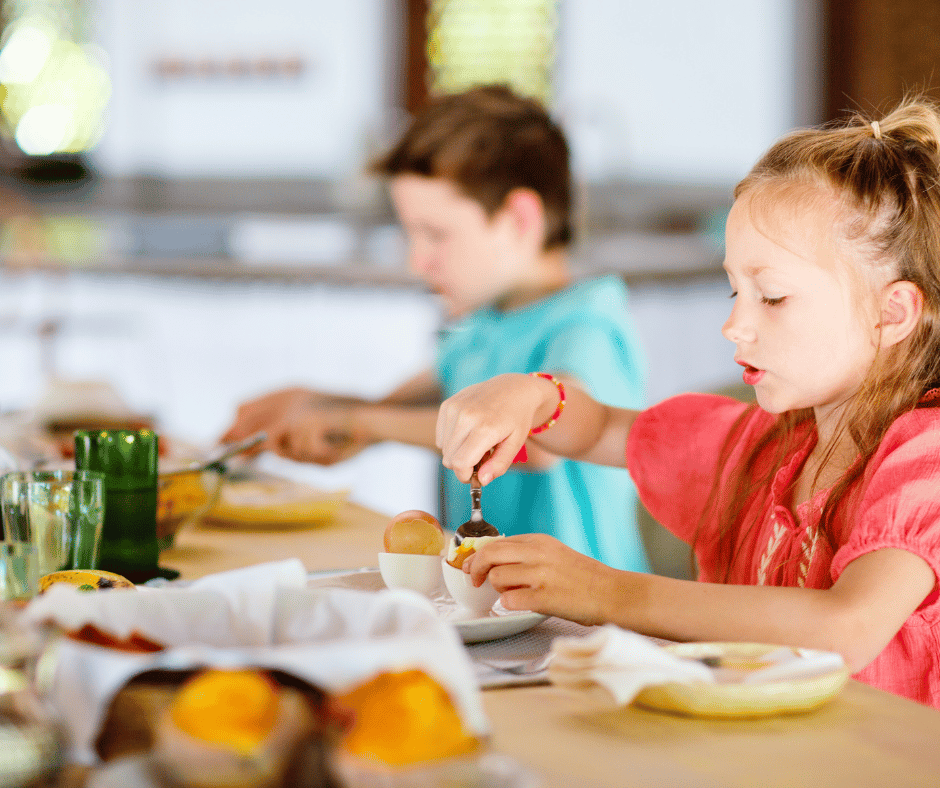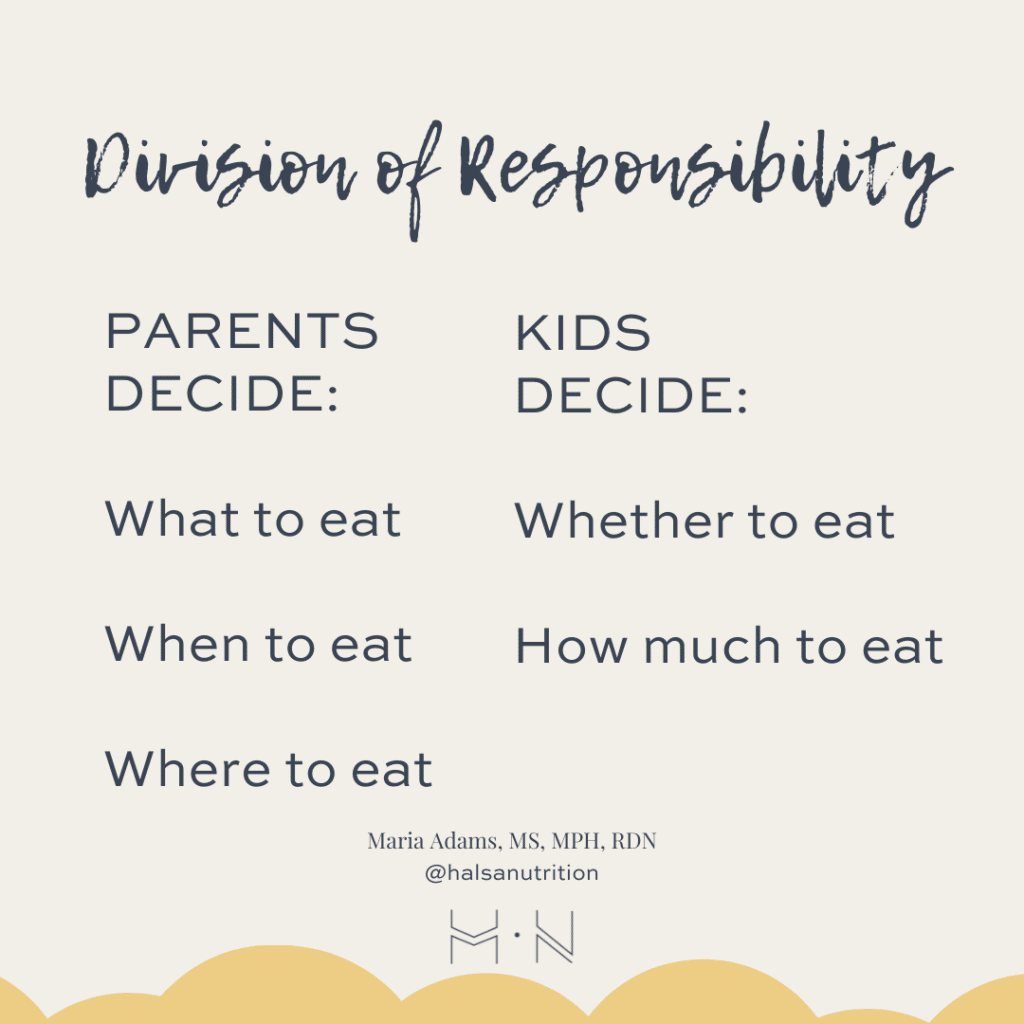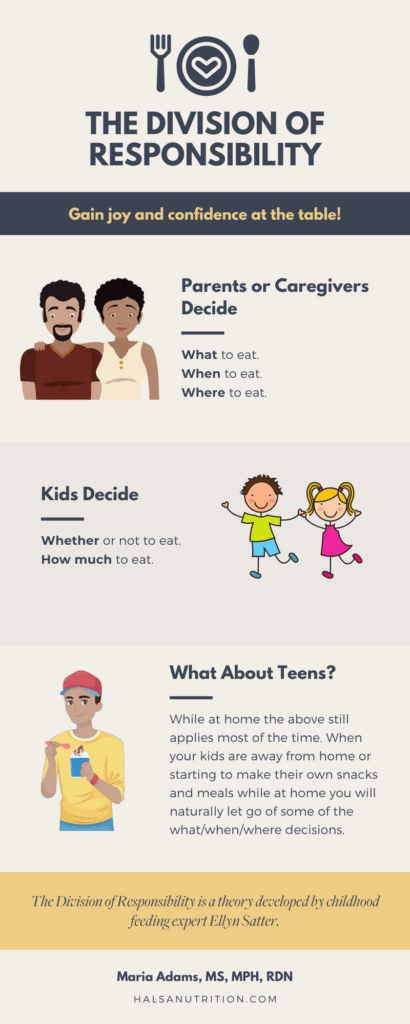
The Division of Responsibility
Implementing the Division of Responsibility can help you feel more confident and less stressed about feeding your children, whether you have toddlers or teens.
Estimated reading time: 5 minutes

Disclosure: Some of the links below are affiliate links. This means that at no additional cost to you, if you click through and make a purchase I will earn a commission.
Feeding Kids Can be Stressful
Being a parent is not easy, we are all just doing our best with everything, including feeding our kids. Honestly, feeding my kids and the dinner battle was one of the parts I struggled with most when my kids were younger.
What finally took (most!) of the stress out of feeding kids for me? Learning and embracing the Division of Responsibility. It was seriously life-changing, and it can be applied to kids of all ages–not just younger ones!
The Division of Responsibility
Basically, this theory, developed by childhood feeding expert Ellyn Satter, says that parents are responsible for deciding what, when, and where a child should eat. The child is responsible for deciding whether or not to eat the food served and how much to eat.
Taking the Pressure off You and Your Child
Realizing that we don’t have control over whether our child even takes one bite of food is a game-changer. Sure, we can gently encourage them to taste it or even just smell it or touch it, but that should be the extent of our request. In other words, skip the:
- nagging,
- orders,
- and bribing.

Letting Go of Comments
It is also helpful to know that there is no need for statements such as:
- “Just one more bite”
- “Finish your broccoli” or
- “Only 1 cookie.”
Statements like these can often do more harm than good when it comes to helping your child develop a healthy relationship with food. They can also take the joy right out of mealtime!
Examples: Your child eats only the chicken and pasta without touching the broccoli. Resist the urge to comment. This will make them more likely to try it next time. Your child eats two tiny bites of fish and leaves the rest. Again, it can be tempting to say “just one more bite”, but resist the urge to comment.
Your best bet is actually to skip food and nutrition talk altogether!
Desserts & the Division of Responsibility
When it comes to desserts and sweets, Satter recommends handling them a little differently. In general, limit desserts to one serving per person at mealtimes, but allow kids to at as much as they want when sweets are served as a snack or fika.
If you are serving brownies as a dessert, limit it to one per person. According to Satter, “logic is that kids take the easy way out, sweets are much easier to learn to eat than meat or vegetables, so it is easy for kids to fill up on dessert and have no reason to explore other mealtime food.”
However, Satter also points out that this limitation creates dessert scarcity, so to make sure they feel like they are getting as much as they want, when you serve something like brownies at snack time, you can put out a whole plate with more than enough for everyone and let them eat until satisfied.
While limiting the servings of dessert would not be recommended in intuitive eating, it is a little different when kids are still learning to like meat and vegetables. However, in general, when it comes to meals and snack time, trust that your kids know how much they need to eat and know that interfering with this can lead them to view this food as forbidden and engage in behaviors such as bingeing or sneaking it to their rooms.
Check out this post for more tips on helping your child establish a positive relationship with food.
Dinnertime Conversation
Your best bet is actually to keep table talk to topics unrelated to food. If you find that mealtimes are a constant battleground, begin implementing the division of responsibility and see how it gradually changes. Also, be sure to check out this post on 20 tips for more joyful family dinners.
Implementing the Division of Responsibility with Older Kids
Obviously, once your kids are tweens and teens they will have more freedom with snacks and some meals. At these ages, they are probably the ones picking out their own snacks and even deciding when snack time is, but since you are still in charge of stocking the snacks, you do have some control there. You also still have control over “where” you would like them to eat their snack (e.g., perhaps not in front of the video game console or computer). And, you still have control of the “what” and “when” for the meals and snacks you serve.
For more tips on feeding teens, check out this post on intuitive eating for teens.
Resources
For more information on the Division of Responsibility check out the Ellyn Satter Institute. I also highly recommend these books:
- How to Raise an Intuitive Eater by Sumner Brooks and Amee Severson
- Child of Mine, by Ellyn Satter
- Secrets of Feeding a Healthy Family, by Ellyn Satter
Or contact me! I’m currently taking on a small number of clients in my private practice. You can also send me your questions via email, Facebook, or Instagram.

Leave a Reply